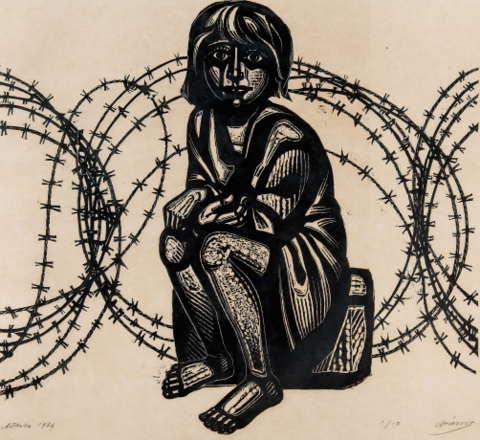
The testimony of displacement through the visual arts of the last fifty years
London, UK – The High Commission of the Republic of Cyprus is hosting an art exhibition dedicated to the Refugee Stamp of Cyprus, instituted by the island’s Government soon after Turkey’s invasion in 1974. The stamp features an exceptional work of art that has had a major impact on the culture of Cyprus during the last five decades. The exhibition, curated by the art historian Maria Paphiti, will be inaugurated on 24 January 2024, 7:00 pm, by the High Commissioner of Cyprus in the UK, H.E. Ambassador Andreas Kakouris. The distinguished Cypriot psychologist Dr. Linda Papadopoulos will recite poetry relevant to the exhibition.
The exhibition will remain open until 2 February 2024.

In September 1974 the Government of Cyprus established a stamp with the purpose of aiding the refugees resulted from the Turkish invasion of Cyprus that had occurred a few weeks earlier. The so-called Prosfigosimo, literally meaning, “refugee stamp”, has since then been a painful reminder of the invasion and occupation of 37% of the territory of Cyprus. The stamp is still affixed to everything mailed by the Cyprus Post, not only within Cyprus but also abroad, thus informing the international community about the pending Cyprus issue.

The familiar Refugee stamp portrays a girl sitting on a suitcase amidst barbed wire. It is entitled Cyprus 1974 and it is an astounding work of art in its own right. It was created by the celebrated Greek engraver A. Tassos (1914-1985).
The present exhibition, conceived and curated by the art historian Maria Paphiti, was first hosted in Spring 2023 by the House of Representatives of Cyprus under the auspices of its President, Mrs. Annita Demetriou. The artworks document the process through which the Refugee stamp was created, based on archival and philatelic material, as well as relevant artworks. It showcases details of A. Tassos’ woodcut and demonstrates its effect on the artistic production of Cyprus in the subsequent five decades.

The exhibition comprises emblematic paintings and engravings by one of the “fathers of Cypriot art”, Telemachos Kanthos (1910-1993), the renowned artists Lefteris Economou (1930-2007) and Andreas Ladommatos (1940) and
prominent contemporary artists, such as George Gavriel (1959), Michalis Kountouris (1960), Lia Lapithi (1963), Andreas Nicolaou (1966), Panayiotis Pasantas (1971), Elena Sarri Varnava (1956), Jane MacLean, Katerina Christodoulou (1960) and the George Pantazis (1965-2023). Many of the artworks displayed derive from photographs of the popular London-based, Doros Partasides (1944), who was at the forefront of war as a photographer and
cameraman of the CyBC in 1974 and also participates in the exhibition with further material.
The works of art visualise the consequences of displacement that apply to all refugees, thus proving that pain and loss, primordial expressions of human nature, remain unchanged, regardless of time and place.
The exhibition is supported by the Deputy Ministry of Culture of Cyprus.





